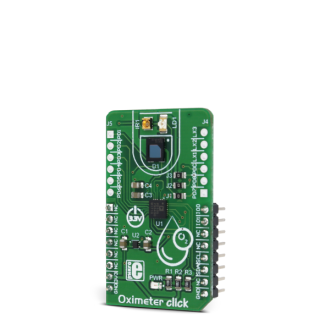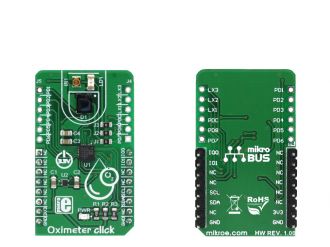
We strongly encourage users to use Package manager for sharing their code on Libstock website, because it boosts your efficiency and leaves the end user with no room for error. [more info]

Rating:
Author: MIKROE
Last Updated: 2018-07-20
Package Version: 1.0.0.0
mikroSDK Library: 1.0.0.0
Category: Biometrics
Downloaded: 5439 times
Not followed.
License: MIT license
Oximeter click is a versatile photometric Click board, perfectly suited for measuring the blood oxygen saturation. It employs ADPD105, a highly configurable photometric front end (AFE) device from Analog Devices.
Do you want to subscribe in order to receive notifications regarding "Oximeter click" changes.
Do you want to unsubscribe in order to stop receiving notifications regarding "Oximeter click" changes.
Do you want to report abuse regarding "Oximeter click".


Library Description
The library can communicate with the device via I2C driver by writing to the registers and by reading from the registers, including data registers. The library has the ability to measure the level of oxygen (O2) in the blood, something like blood pressure. Library also can configure the device to works in two Time Slot Mode independently with different configurations. For more details check the documentation.
Key functions:
uint8_t oxim_writeReg( uint8_t register_address, uint16_t transfer_data ) - The function writes 16-bit data to the register.uint8_t oxim_setTimeSlotA( uint8_t enableSlotA, uint8_t enablePhotodiode, uint8_t enableLED, uint8_t setMode ) - The function performs the configuration for Time Slot A and enables the interrupt for this Slot.uint8_t oxim_enableChannels( uint8_t selectChannel ) - The function determines which channel/channels be enabled.void oxim_readData( uint32_t *channResults, uint8_t resultMode ) - Function reads data in the desired mode for determined Slot.Example description
The application is composed of three sections :
void applicationTask()
{
oxim_plotDisplay();
}
Additional Functions :
Other mikroE Libraries used in the example:
Additional notes and information
Depending on the development board you are using, you may need USB UART click, USB UART 2 click or RS232 click to connect to your PC, for development systems with no UART to USB interface available on the board. The terminal available in all MikroElektronika compilers, or any other terminal application of your choice, can be used to read the message.